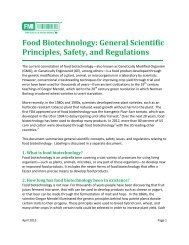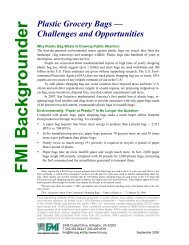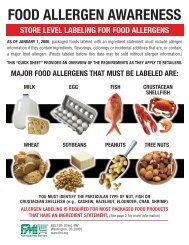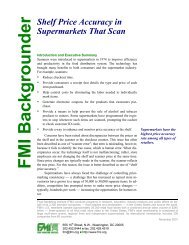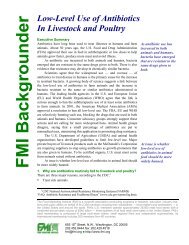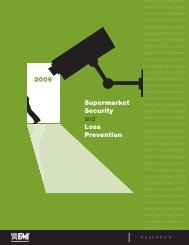Untitled - Food Marketing Institute
Untitled - Food Marketing Institute
Untitled - Food Marketing Institute
Create successful ePaper yourself
Turn your PDF publications into a flip-book with our unique Google optimized e-Paper software.
Nutrition Education of Customers<br />
Consumers who value food and understand the importance of nutrition increase the<br />
market demand for healthier foods including fresh produce, dairy products and lean<br />
meats. Innovative education programs, such as cooking classes and community<br />
gardens, can enhance demand for and interest in healthier foods.<br />
Innovative Ways to Provide Healthier <strong>Food</strong> in Underserved Areas<br />
Smaller Store Formats<br />
Some retailers are designing stores to fit in less than 10,000 square foot spaces.<br />
Smaller stores have less inventory and selection than full-scale stores, but do offer<br />
all of the essentials households want in terms of fresh and perishable items. In<br />
addition, smaller formats have lower operating costs because they require less<br />
staff, inventory and have lower utility costs. Several retail chains are<br />
experimenting with smaller models (e.g., Hy-Vee and Safeway) and others are<br />
planning to open smaller format stores (e.g., Walmart).<br />
Alternate Grocery Delivery Systems<br />
Instead of delivering groceries to homes, some retailers are delivering to<br />
centralized locations such as libraries, schools or faith communities. Success<br />
requires that labor and transport costs, logistics and storage issues be addressed.<br />
One example of how this type of system has successfully worked is Angel <strong>Food</strong><br />
Ministries. Using an online ordering system, customers order pre-packaged food<br />
boxes designed to feed a family of four for one week. Orders are delivered once<br />
per week to designated host sites (typically churches).<br />
Enhanced Transportation Options<br />
Transportation to nearby grocery stores is a common issue for residents living in<br />
low access urban and rural areas. Expanding public or private transportation<br />
networks can increase accessibility as can providing or subsidizing transportation in<br />
these areas. Through a combination of public and private efforts, it is possible to<br />
make accessibility easier for customers without personal transportation to access<br />
grocery stores.<br />
11<br />
Access to Healthier <strong>Food</strong>s: Opportunities and Challenges for <strong>Food</strong> Retailers in Underserved Areas




